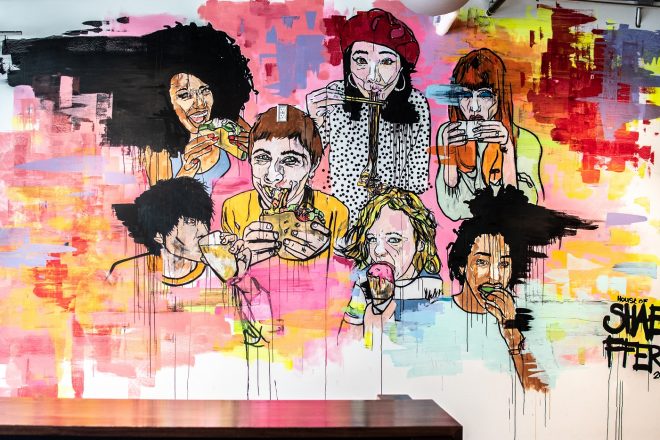PROCESS PIECE

Little Rock–based artist Michael Shaeffer creates a mural at the Momentary in Bentonville.
WORDS / PHILLIP HUDDLESTON
PHOTOS / LYNDSEY SUZANNE
“Think of all the chicken spirits.” This isn’t Michael Shaeffer’s first consideration while creating a mural, but the thought becomes more prevalent throughout the night. He chuckles to himself as he dabs hot pink paint on a cheek, down an ice cream scoop, and all about the background. “This used to be a chicken processing plant. No one’s here at night so no one would know. Last thing I’d wanna see is 1,000 chicken ghosts floating on the wall.”
Shaeffer risks these haunted nights (or poultry-geists if you will) to create a mural at Bentonville’s 8th Street Market. Within the span of 72 hours, he will make his first and last brush strokes before driving back to central Arkansas to pick up his son, Stokely. And this mural—like so many that have sprouted up around the city, state, and nation—will appear to have manifested out of thin air overnight. Or, in this case, three nights.
On the second night of painting, Shaeffer and his girlfriend, Brooke Eastburn, enter the empty space and move the tables and benches aside. A drop cloth is placed beneath the 18-by-12-foot wall. A line of brushes and paints are sorted along the bench and floor. A small bluetooth speaker is set on a nearby tabletop. Eastburn sighs as the music begins. “It’s the same 30 songs,” she says, referring to the 114-hour-long playlist that sets a calming but up-tempo pace. She laughs pointedly at Shaeffer. “Oddly enough, he only listens to Beth Orton.” Shaeffer volleys the response, “Or Portishead,” which is returned by Eastburn with “Or PJ Harvey.” The two continue this love-and-jest rapport, keeping spirits high for the many hours Shaeffer adds base colors, refines contours and finesses details. The banter is one of many stimulants needed to illustrate seven different figures in one weekend. Last night’s endeavors went well past sun up; those of tonight and tomorrow night are likely to do the same. While the music and good company are helpful, Shaeffer reaches down into a cooler to pull out his true secret weapon: an energy drink he holds up and refers to as his “Go-Go juice.”
Shaeffer did have the option of painting during the day and avoiding the long nights, chicken spirits, and Go-Go juice, but this was out of the question. “No way I could do this while they were open,” he explains. “I need to be able to work on it without having to think about everyone watching.” Shaeffer goes on to envision the market patrons critiquing each addition to the mural. He explains how working in front of an audience would become a kind of performance piece. “I would second-guess how I’m painting the whole thing.” And even still, as Shaeffer goes back to his thoughts of paint, composition and the ever-decreasing amount of time left, there is a beauty in the empty parking lot surrounding the closed market, the trebly warble of a mini-speaker interrupted by the blurp of the ice cream shop fridge, the slow and steady application of color across a once-white wall.
When the painting is complete, each of the seven portraits will be rendered in Shaeffer’s loose and punkish style; but for now, he is articulating the fleshy forms of a singular figure: Stokely, his 6-year-old son. The only child in the work, Stokely gnaws at a melting ice cream cone. Shaeffer beams as he flicks driplets of ice cream–colored paint onto the wall. “So I picked Stokely up from school one day and said, ‘I’m gonna need your help today. I’m gonna need to draw you eating an ice cream cone.’ Stokely told me he’d never had an ice cream cone. He’d just had cups. That’s when I realized I’m gonna get to paint my son having his first ice cream cone.” Stokely’s eyes stare down the room with that intensity of pleasure and pain—the sharp coldness of a front-toothed bite into one’s first ice cream cone.
Shaeffer steps back from the portrait as he wipes his hands on his pants—his thighs covered in a Pollock-like variety of pigment. He assesses his progress with folded arms. After these murals appear, it’s difficult to imagine the blank wall that was once there. These nights reveal the real magic of a mural: the artist’s sleight of hand that disguises this process brushstroke by brushstroke. Shaeffer studies the portrait. He’ll see Stokely in two days and tell him all about the mural. Stokely’s face will light up at the thought of being immortalized somewhere for the public to see. Tonight, Shaeffer points at the portrait of his son. “I gotta go over it there and there.” He checks the time, sighs, and moves to another portrait. “It’s not finished yet. I’ll come back to it.”





Comments